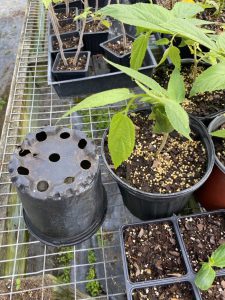We have officially reached the season of cooler weather (well, cooler weather for Florida that is). It also means there’s cooler things to plant, and we begin to see some of our favorite northern vegetables migrate down to Florida for the holidays. If you want to grow vegetables and harvest your own food, but don’t have the space, then look no further because potted plants are here.
Potted plants or, more commonly referred to as, container gardening, is an effective way to grow sizable amounts of produce with less work and space. For example, in one square foot you can grow a tomato plant, a head of cabbage, 4 heads of lettuce, 9 plants of bush beans, 9 radishes, 4 strawberry plants, an array of herbs, and the list goes on and on. So don’t toss that old 5-gallon bucket, it may just be able to provide a sizable harvest this season.
It doesn’t have to stop at a bucket, there are many different pots of shapes and sizes that can suit your garden style. Are all pots made equal? No. Are all pots perfect for all types of plants? Also no. You’ll need to know three major factors when picking a good pot: how your pot functions, how your plant functions, and how you function.
When picking your pot, check to see what it’s made of. Will it break down in the sun, is it flimsy, and is the quality good enough that you won’t have to replace it shortly after. Material is somewhat important to picking a pot, however drainage is often the most important factor.
How well does your pot release the water that drains through the soil?
Many plants you’ll grow (but not all) will not like to have “wet feet,” which means their roots sitting in stagnant water. Often this is because fungal issues can occur when roots sit in the water for too long, and water can also suffocate roots. At the extension, we use nursery pots, they’re cheap, small, and drain very well. I often suggest nursery pots to those starting out because they are not a massive investment and come in various sizes.

Once you’ve looked over your pot selection, it’s important to then know what you’re trying to plant.
Plants have different root depths and widths. Don’t know how many plants you can put in one pot? You can use our Florida Vegetable Gardening Guide (https://edis.ifas.ufl.edu/pdf/VH/VH021/VH021-Dk6jmncj9h.pdf), on page 6 there is a table that explains the number of each plant that fits within 10 square feet. Once you know the number of plants per square foot you can compare it to the number of square feet your pot’s surface is.
When planting rood crops, such as beets, carrots, or potatoes, look for the approximate depth the plant will need to grow based on the cultivar you purchased. If you need help with plant spacing or root depth, always feel free to reach out to UF/IFAS Extension and we can certainly help.
Finally, after you’ve selected the right plant and the right pot, there is one last important consideration: weight.
There is a large selection of beautiful pots and containers that are perfect for holding many types of plants. However, ask yourself, if you need to move this pot, will you be able to lift it on your own or will you need a forklift?
If you want heavy pots, go for it, but consider it first. The University of Delaware states that just one cubic foot of soil heavily saturated with water can way up to 100 pounds. In some cases, many movable pots can triumph over a few large, immovable pots.
Overall, there are many factors to consider when picking out the right pot for the right place. However, pot function, plant function, and lifting are three that we consistently consider when selecting the right pot to plant in at the extension.
Source: UF/IFAS Pest Alert
Note: All images and contents are the property of UF/IFAS.



